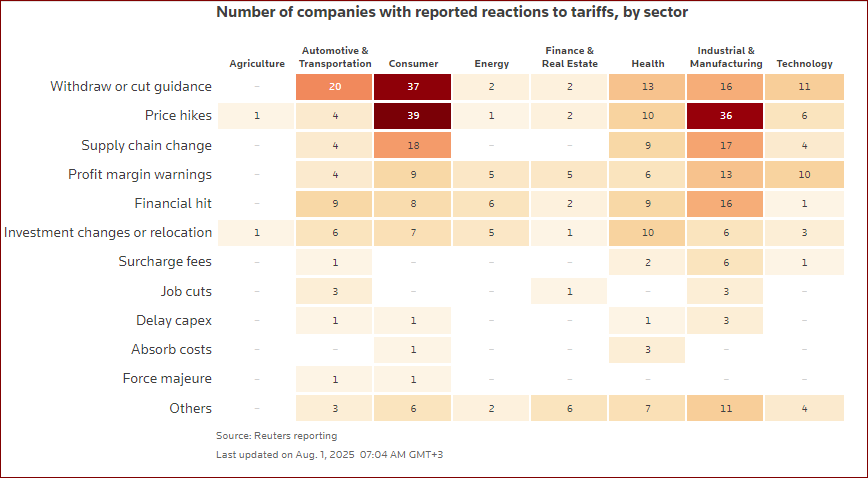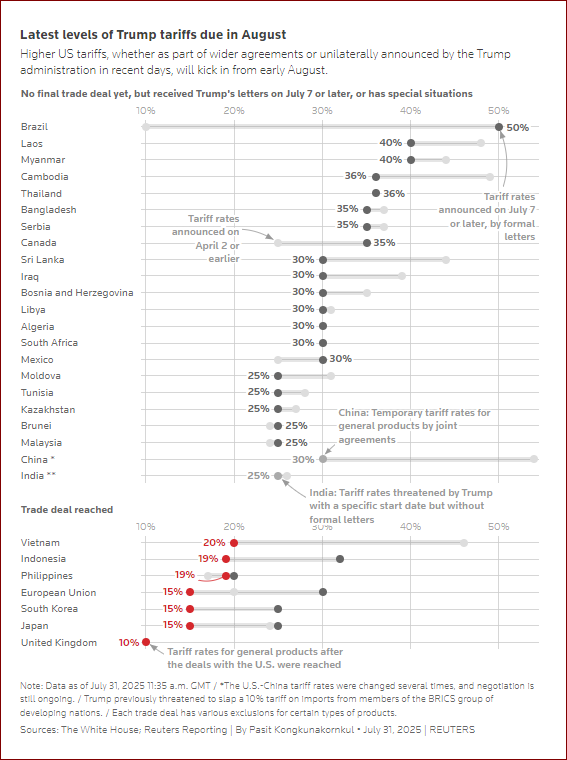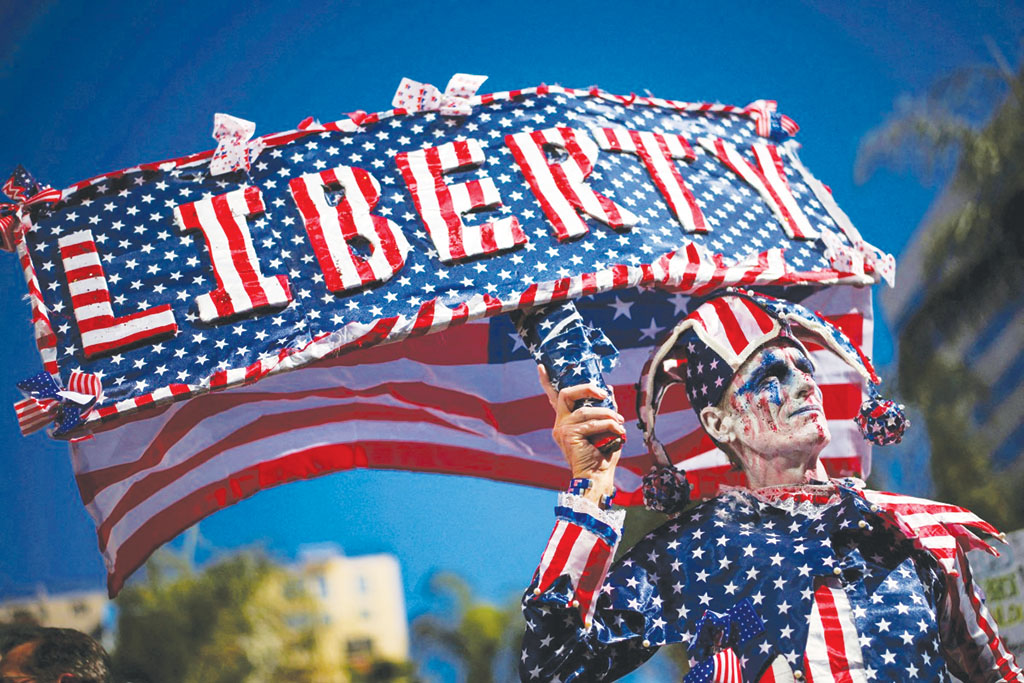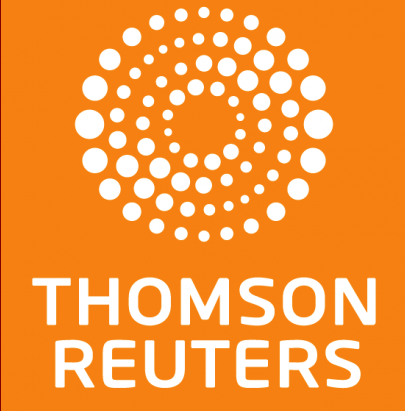U.S. President Donald Trump‘s latest wave of tariffs on exports from dozens of trading partners, including Canada, Brazil, India and Taiwan, sent global markets tumbling on Friday as countries pushed for talks to clinch better deals.
Trump’s new tariff rates include a 35% duty on many goods from Canada, 50% for Brazil, 25% for India, 20% for Taiwan and 39% for Switzerland.
The presidential order listed higher import duty rates of 10% to 41% starting in seven days for 69 trading partners, effectively taking the U.S. effective tariff rate to about 18%, from 2.3% last year, according to Capital Economics.
Global shares stumbled, with the Stoxx 600 .STOXX down around 1% in the first hour of trading, and 1.7% lower on the week and set for its biggest weekly drop since early April.
Both Nasdaq futures NQc1 and S&P 500 futures ESc1 were down around 1%.
The market response was not as volatile as April’s global asset declines, said Wei Yao, research head and chief economist in Asia at Societe Generale, referring to the market slide after Trump’s initial tariffs announced on April 2.
“We are all getting much more used to the idea of 15-20% tariffs being manageable and acceptable, thanks to the worse threats earlier,” she said.
But Trump’s tariff rollout comes amid evidence they have begun driving up prices.
U.S. Commerce Department data released Thursday showed prices for home furnishings and durable household equipment jumped 1.3% in June, the biggest gain since March 2022.
GRAPHIC-How companies are responding to Trump’s tariffs

Countries hit with hefty tariffs said they will seek to negotiate with the U.S. in hopes of getting a lower rate.
Switzerland said it would push for a “negotiated solution” with the U.S.
“I am stunned. These tariffs are based on no rational basis and are arbitrary,” said Stefan Brupbacher, director of manufacturers’ association Swissmem.
Taiwan President Lai Ching-te said the new 20% tariff rate for the island was “temporary ” and that he expected to reach a lower figure.
South Africa’s Trade Minister Parks Tau said he was seeking “real, practical interventions” to defend jobs and the economy against the 30% U.S. tariff it faces.
Southeast Asian countries breathed a sigh of relief after the U.S. tariffs on their exports that were lower than threatened and levelled the playing field with a rate of about 19% across the region’s biggest economies.
Thailand’s finance minister said a reduction from 36% to 19% would help his country’s economy.
“It helps maintain Thailand’s competitiveness on the global stage, boosts investor confidence and opens the door to economic growth, increased income and new opportunities,” Pichai Chunhavajira said.
Australian products could become more competitive in the U.S. market, helping businesses boost exports, Trade Minister Don Farrell said, after Trump kept the minimum tariff rate of 10% for Australia.
But businesses and analysts said the impact of Trump’s new trade regime would not be positive for economic growth.
“No real winners in trade conflicts,” said Thomas Rupf, co-head Singapore and CIO Asia at VP Bank. “Despite some countries securing better terms, the overall impact is negative.”
“The tariffs hurt the Americans and they hurt us,” winemaker Johannes Selbach said in Germany’s Moselle Valley.
“Thousands of families who produce wine in Europe and thousands of families in the importing, wholesaling, retailing, restaurant business in the U.S. are dependent on the flow from both sides,” he said, adding jobs and profits would be hit.
Goods from all other countries not listed in Trump’s executive orders will face a 10% U.S. import tax. Trump had previously said that rate might be higher. The administration also teased that more trade deals were in the pipeline.
GRAPHIC-Latest levels of Trump tariffs due in August

The Republican president has tapped emergency powers, pressured foreign leaders, and pressed ahead with trade policies that sparked a market sell-off when they were first announced in April.
Trump’s order said some trading partners, “despite having engaged in negotiations, have offered terms that, in my judgment, do not sufficiently address imbalances in our trading relationship or have failed to align sufficiently with the United States on economic and national-security matters.”
Trump issued a separate order for Canada that raises the rate on Canadian goods subject to fentanyl-related tariffs to 35%, from 25% previously, saying Canada had “failed to cooperate” in curbing illicit narcotics flows into the U.S.
The higher tariffs on Canadian goods contrasted sharply with Trump’s decision to grant Mexico a 90-day reprieve from higher tariffs of 30% on many goods to allow time to negotiate a broader trade pact.
Canadian Prime Minister Mark Carney said he was disappointed by Trump’s decision, and vowed to take action to protect Canadian jobs and diversify exports.
India is in trade talks with the U.S. after Washington imposed a 25% tariff on New Delhi, a move that could impact about $40 billion worth of its exports, an Indian government source with knowledge of the talks told Reuters on Friday.
China is facing an August 12 deadline to reach a durable tariff agreement with Trump’s administration. A U.S. official told reporters that they are making progress toward a deal.
The European Union struck an agreement on a blanket 15% tariff with the U.S. at the end of July.
The bloc’s trade chief Maros Sefcovic said the framework deal the EU signed with the U.S. gave EU exporters a “more competitive position.”
“This reinforces stability for businesses as well as trust in the transatlantic economy,” he said.







Click here to change your cookie preferences